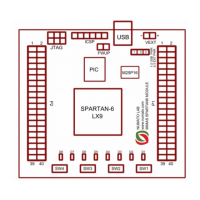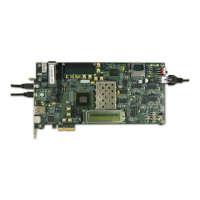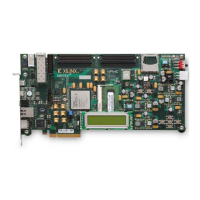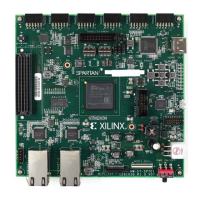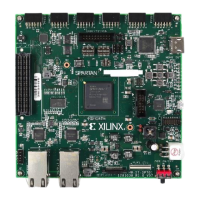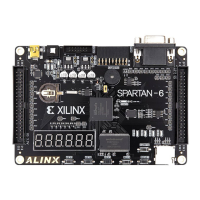28 www.xilinx.com Spartan-6 FPGA PCB Design and Pin Planning
UG393 (v1.1) April 29, 2010
Chapter 2: Power Distribution System
currents and are placed high in the stackup, while low priority pairs carry lower transient
currents (or can tolerate more noise) and are placed in the lower part of the stackup.
Capacitor Effective Frequency
Every capacitor has a narrow frequency band where it is most effective as a decoupling
capacitor. This band is centered at the capacitor’s self-resonant frequency F
RSELF
. The
effective frequency bands of some capacitors are wider than others. A capacitor’s ESR
determines the capacitor’s quality (Q) factor, and the Q factor can determine the width of
the effective frequency band:
• Tantalum capacitors generally have a very wide effective band.
• Ceramic chip capacitors with a lower ESR, generally have a very narrow effective
frequency band.
An ideal capacitor only has a capacitive characteristic, whereas real non-ideal capacitors
also have a parasitic inductance (ESL) and a parasitic resistance (ESR). These parasitics
work in series to form an RLC circuit (Figure 2-5). The RLC circuit’s resonant frequency is
the capacitor’s self-resonant frequency.
To determine the RLC circuit’s resonant frequency, use Equation 2-1:
Equation 2-1
Another method of determining the self-resonant frequency is to find the minimum point
in the impedance curve of the equivalent RLC circuit. The impedance curve can be
computed or generated in SPICE using a frequency sweep. See the Simulation Methods
section for other ways to compute an impedance curve.
It is important to distinguish between the capacitor's self-resonant frequency and the
mounted capacitor’s effective resonant frequency when the capacitor is part of the system,
F
RIS
. This corresponds to the resonant frequency of the capacitor with its parasitic
inductance, plus the inductance of the vias, planes, and connecting traces between the
capacitor and the FPGA.
The capacitor’s self-resonant frequency, F
RSELF
, (capacitor data sheet value) is much
higher than its effective mounted resonant frequency in the system, F
RIS
. Because the
mounted capacitor's performance is most important, the mounted resonant frequency is
used when evaluating a capacitor as part of the greater PDS.
Mounted parasitic inductance is a combination of the capacitor's own parasitic inductance
and the inductance of: PCB lands, connecting traces, vias, and power planes. Vias traverse
a full PCB stackup to the device when capacitors are mounted on the PCB backside. For a
board with a finished thickness of 1.524 mm (60 mils), these vias contribute approximately
300 pH to 1,500 pH, (the capacitor’s mounting parasitic inductance, L
MOUNT
) depending
on the spacing between vias. Wider-spaced vias and vias in thicker boards have higher
inductance.
To determine the capacitor’s total parasitic inductance in the system, L
IS
, the capacitor's
parasitic inductance, L
SELF
, is added to the mounting’s parasitic inductance, L
MOUNT
:
L
IS
= L
SELF
+ L
MOUNT
Equation 2-2
For example, using X7R Ceramic Chip capacitor in 0402 body size:
C=0.01μF (selected by user)
L
SELF
= 0.9 nH (capacitor data sheet parameter)
F
1
2π LC
-------------------=

